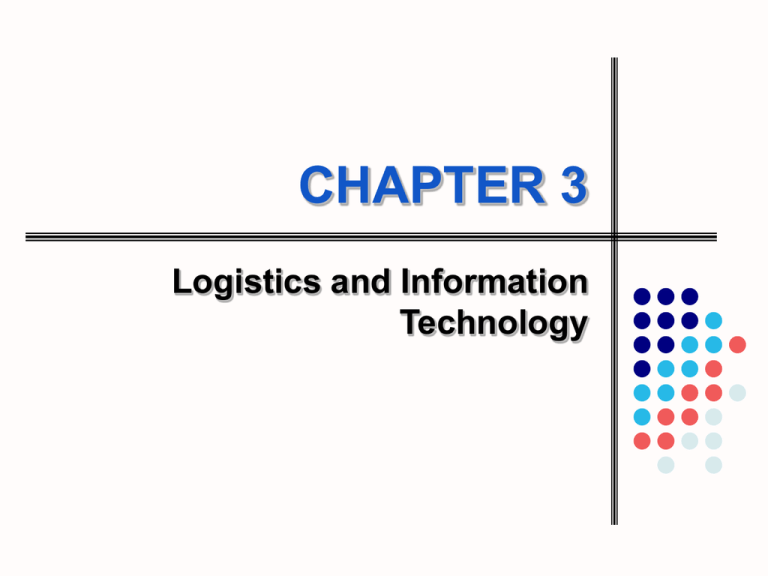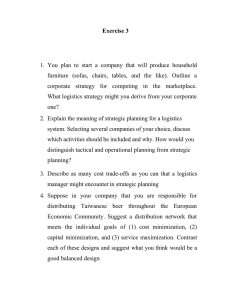CHAPTER 3 Logistics and Information Technology
advertisement

CHAPTER 3 Logistics and Information Technology Four Learning Objectives To appreciate the importance of effective and efficient utilization of information for logistics management To learn about general types of information systems and their logistical applications 3-2 To understand the impact of electronic commerce on channel design To understand key differences between the logistics of e-fulfillment and the logistics of traditional fulfillment 3-3 12 Key Terms Application service providers (ASP) Artificial intelligence (AI) Data mining Decision support system (DSS) E-fulfillment(電子履單) Electronic data interchange (EDI) Enterprise resource planning (ERP) system Logistics exchanges(物流交換 網站) 3-4 Logistics information system (LIS) Office automation system Simulation Transaction processing system (TPS) 3-5 contents 3.1 General Types of Information Management Systems常見的資訊系統 3.2 Electronic Commerce and Logistics 3-6 Benefits of Effective and Efficient Use of Information Replacement of inventory with information Reduced variability in the supply chain Better coordination of manufacturing, marketing, and distribution Streamlined(簡化) order processing and reduced lead-times(前置時間) 3-7 Data: 事實、某些現象之記錄 Information: 協助決策之大量事實 3-8 3.1 General Types of Information Management Systems 有六種,如後圖 3-9 Figure 3-1: General Types of Information Management Systems 3-10 Office automation system (OAS) Process personal and organizational business data Perform calculations Create(建立) documents……Ex: MS office software package 3-11 Communication system Help stakeholders work together by interacting and sharing information Examples of use: Virtual meetings Video conferencing using cell phones (2001後) Voice-based order picking (聲控揀貨: 2002後)…員工周轉率 下降! 3-12 Transaction Processing System (TPS) Collects and stores information about transactions Efficient processing of transactions Real-time processing Batch processing……成本低、較易處理 3-13 Electronic data interchange (EDI) Benefits:減少運輸錯誤、減少退貨等 Drawbacks:缺乏標準格式、電腦軟、硬體不相容性 Global usage:American National Standards Institute ( ANSI)和EDIFACT ( Electronic Data Interchange For Administration Commerce and Transport)兩全球知名機構 已同意進行XML (extensible markup language可擴展標記語 言)專案,如ebXML組織 3-14 Automatic identification technologies Types: Optical character(文字) recognition Machine vision(視覺) Voice-data entry Radio-frequency identification Magnetic strips(磁條) Bar code scanners 傳統的十二碼universal product code (UPC、通用產品代碼)適用於以 包裝為單位之品,無法提供以重量為單位之品所需的細節,因此發展新 的reduced space symbology (RSS、縮減碼型),以便記錄更多資料 3-15 Point-of-sale systems (POS) enhance decision making 3-16 Management Information System (MIS) and Executive Information System (EIS) Convert data into information Logistics information system (LIS): the people, equipment, and procedures to gather, sort, analyze, evaluate, and distribute needed, timely, and accurate information to logistics decision makers.如後 圖 3-17 Figure 3-2: Structure and Function of a Logistics Information System 3-18 Garbage in/ garbage out=GIGO===>若資 訊錯誤、將導致物流人員決策錯誤 3-19 Decision Support Systems (DSS) provide information, models, or analysis tools 較重要之四種: Simulation:常以線性方程式表示、測試改變的可行性 Artificial Intelligence (AI):如neural networks and fuzzy logic and expert systems Application specific software:如SCM, TMS, WMS。廠商 有i2 technology智佳科技、SAP思愛普、JDA/Manugistics、 Manhattan Associates Data mining:如:某些商品周轉較慢……客戶卻為採購金 額較高之家庭! 3-20 Enterprise resource planning (ERP) All company functional areas use a common database to: Standardize manufacturing processes Integrate financial data Standardize human resource data Shortcomings Costs of installation Time-consuming installation process 3-21 廠商有:J.D. Edwards, Peoplesoft(仁科) [上 述二家已併入甲骨文], Baan [併入Infor] 3-22 3.2Electronic Commerce and Logistics Internet impacts include: Logistics functions: 使用量最高為: Transportation Order management Channel design 3-23 Intermediaries (物流中介商) 4 categories of logistics exchanges Enhancing procurement services Matching shippers (貨主)and carriers Executing relevant transactions Transacting with partners………….Ex: Nistevo [已併入Sterling Commerce] Application service providers (ASP) provide access over the Internet to applications and related services (that would otherwise have to be located in enterprise computers). 3-24 E-Fulfillment is the coordinated inbound and outbound logistics functions that facilitate the management and delivery of customer orders placed online. 3-25 兩者比較… E-fulfillment Many logistical functions and activities occur More, smaller orders Order management and information management systems must handle large volumes of orders Smaller orders dictate open-case picking Traditional Fulfillment Many logistical functions and activities occur Fewer, larger orders Order management system is set up to handle orders from resellers, not consumers Full-case picking Warehouse set up to handle large volume orders 3-26 E-fulfillment Products slotted to facilitate picking smaller orders Totes(運送帶) and push carts used Packaging is small cartons(紙板箱), envelopes, bags suited to holding small quantities Traditional Fulfillment Warehouse set up to handle large volume orders Variety of materials handling equipment used Packaging generally cartons that hold large volume orders 3-27 E-fulfillment Transportation companies used with extensive delivery networks; experience in parcel shipments Outbound shipments usually picked up by vans Return rates much higher and from ultimate consumers Traditional Fulfillment Transportation methods and companies vary by request of buyer Outbound shipments may be picked up by tractor trailers or railcars Return rates lower and from resellers 3-28



